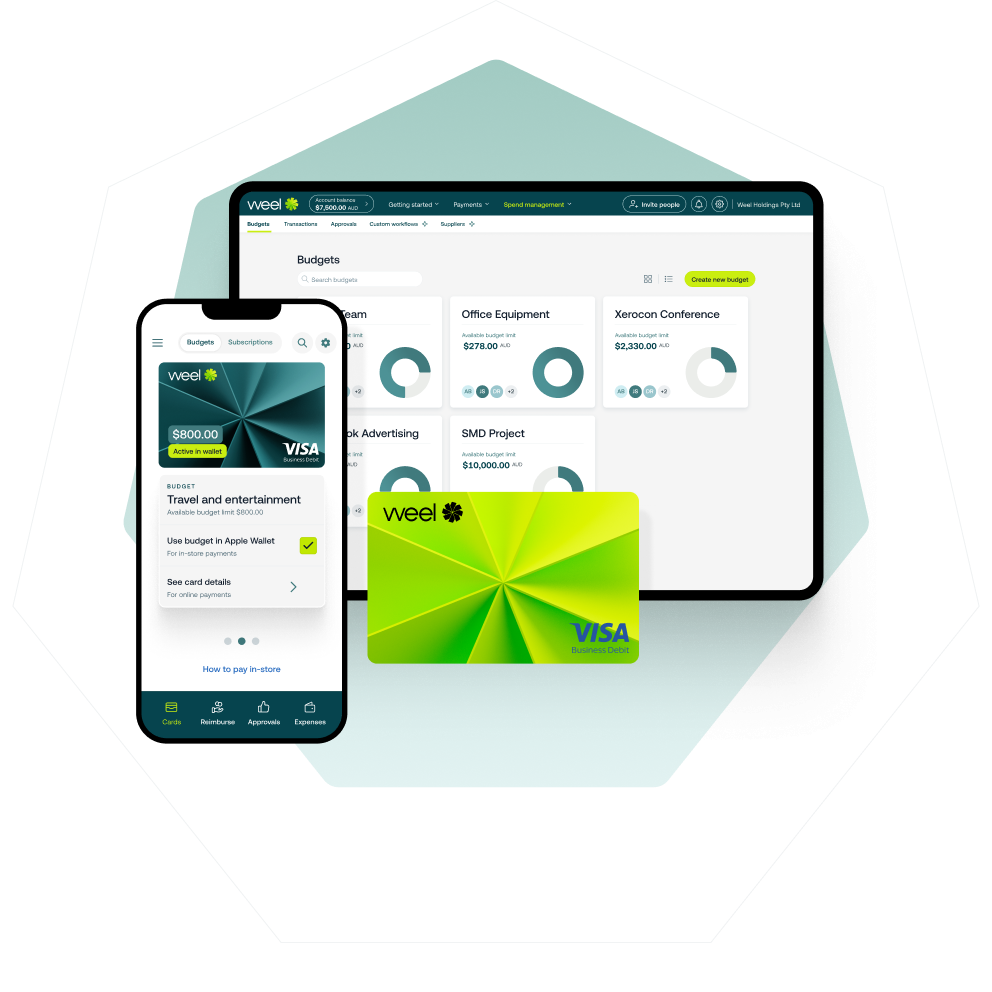In this guide, we'll explain what employee expense reimbursement is, the most common types of business expenses, and how modern solutions like Weel can transform this once-tedious process into a quick, painless part of the day.
What is employee expense reimbursement and how does it work?
Employee expense reimbursement is the process where businesses pay back staff for work-related expenses they've covered with their own money. These costs usually include travel expenses, client lunches, office supplies, and other business-related purchases.
From a tax perspective, these payments have important implications. The employer may be subject to fringe benefits tax (FBT). When a reimbursement is covered by FBT, the employee can't claim a deduction for that expense on their tax return.
Common types of employee expense reimbursements

The Fair Work Act requires employers to compensate employees for certain costs directly related to their employment. For everything else, businesses develop their own expense policies based on industry standards and operations.
Here are the most common types of expenses that companies typically reimburse:
Travel expenses
Travel reimbursements cover costs incurred during business trips, like:
- Short airfares
- Ubers and taxis
- Accommodation
- Meals while travelling
- Parking fees and tolls
- Rental cars
Office supplies and equipment
If an employee buys office supplies, they may be reimbursed. Here are some examples:
- Stationery and printer supplies
- Small office equipment
- Software purchases
- Books and reference materials
Client entertainment
Workplaces reimburse any cost associated with meeting a client, like:
- Coffee bills
- Lunch and dinner bills
- Venue bookings for meetings
Professional development
Many companies reimburse expenses related to improving employees' skills:
- Conference and seminar fees
- Educational or work-related subscriptions
Most companies don't expect employees to cover substantial work-related expenses out of pocket. Higher-cost items like expensive airfares or conference tickets should be paid for directly by the employer.
Steps in the employee reimbursement process

Most businesses handle expense reimbursements in a similar way. From start to finish, it usually goes like this:
- Submission of expenses
- Expense approval workflow
- Payment processing
Submission of expenses
An employee pays for a business expense with their personal funds and submits the receipt to the finance department. The employee must:
- Collect itemised receipts for all expenses
- Complete expense report forms
- Categorise expenses correctly
- Submit within the timeframe set by company policy
Digital expense management systems make this process much easier by allowing employees to capture receipts on their mobile phones and submit claims electronically.
Expense approval workflow
Once it’s submitted, the expense goes through an approval process:
- Manager reviews for policy compliance
- Finance team checks the documentation
- Multi-level approvals may be needed for larger expenses
The approval workflow should be clearly defined in your expense policy so employees know who needs to sign off on their expenses and how long it will take.
Payment processing
Once expenses are approved, the final step is getting money back to employees:
- Finance team processes the reimbursement
- The payment is made
- The transaction is recorded
Modern reimbursement platforms like Weel can automate this process, allowing for same-day reimbursements that keep employees happy and finances in order.
Best practices for employee expense reimbursement

Most businesses struggle with expense reimbursements at some point. The process often takes too much time and can create frustration between employees and the finance team.
Here’s how you can create a reimbursement system that's simpler and more efficient for everyone.
1. Create a clear expense policy
Develop a clear expense policy that outlines what can be claimed, when it can be claimed, documentation requirements, and approval processes.
2. Identify your spenders
Categorise employees based on their spending patterns. For infrequent, low-value purchases (under $50), reimbursements may be appropriate. For regular or high-value spenders, corporate cards are usually better.
3. Automate where possible
Use expense management software to automate submission, approval, and payment processes.
4. Provide training
Don’t assume employees know how to claim. Show them exactly how to properly submit expense claims.
5. Regularly review and update processes
Continuously improve your reimbursement procedures based on feedback, the latest technologies and changing business needs.
For more advice, see our blog on streamlining employee expenses and reimbursements.
How to reimburse employees for expenses using automation
Comparing traditional methods with modern solutions shows why automation is transforming expense management:

Why choose Weel for employee expense reimbursement
Weel simplifies expense reimbursements so your team can focus on more important work.
Your small spender team can submit expenses on the go using the Weel app, making the process quick and simple. For employees who make frequent or big-ticket purchases, Weel also offers virtual corporate cards. Our comprehensive approach to spend management gives you the flexibility to choose the right solution for each team member.
Our platform also easily connects with Xero and other accounting systems, eliminating double-handling and manual reconciliation.
Book a demo with Weel
Ready to improve how you handle employee expenses? Book a personalised demo with Weel to see how our software helps your business process reimbursements faster, simplify approvals, and track spending more efficiently.





.jpeg)




.jpeg)



